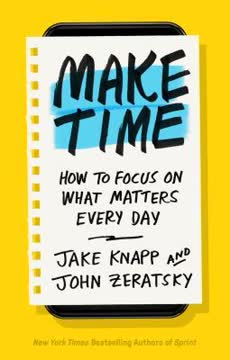Key Takeaways
1. The Pomodoro Technique: Focus on One Activity at a Time
"You can't dance at two weddings with one rear end."
The power of single-tasking. The Pomodoro Technique, developed by Francesco Cirillo in 1992, is a time management method that uses 25-minute focused work sessions called "Pomodoros." This technique is based on the principle that concentrating on one task at a time leads to higher productivity and better quality work.
Overcoming procrastination and distractions. By breaking work into manageable chunks and providing regular breaks, the Pomodoro Technique helps overcome procrastination and reduces the impact of distractions. It creates a sense of urgency and accomplishment with each completed Pomodoro, motivating users to stay focused and productive.
Key benefits:
- Improved focus and concentration
- Reduced mental fatigue
- Increased awareness of time usage
- Better work-life balance
- Enhanced productivity and quality of work
2. Understanding Your Brain's Context for Optimal Performance
"The prospects for getting into the flow are much better when you are rested, seated, and focused than when you are just hanging around and waiting for inspiration."
Brain structure and function. Understanding how your brain works is crucial for optimizing your performance. The brain consists of four main layers: the brain stem, limbic system, cortex, and frontal lobe. Each layer has specific functions that contribute to our cognitive abilities and behavior.
Cognitive rhythms and limitations. Our brains operate on various rhythms and have limitations in processing information. The working memory, for instance, can only handle a limited amount of information at once. Recognizing these limitations helps in designing effective work strategies.
Key brain functions affecting productivity:
- Attention and focus
- Memory formation and recall
- Decision-making and problem-solving
- Emotional regulation
- Creativity and innovation
3. Implementing the Mechanics of the Pomodoro Technique
"Getting thoughts out of your head is mandatory if you want to be able to stay focused."
The five stages of the Pomodoro Technique. Implementing the technique involves five key stages: Planning, Tracking, Recording, Processing, and Visualizing. This systematic approach ensures that you not only manage your time effectively but also continuously improve your productivity.
Essential tools and artifacts. The technique requires minimal tools: a timer (traditionally a tomato-shaped kitchen timer), a pen, and three sheets of paper for the To Do Today, Activity Inventory, and Records. These simple tools help externalize your thoughts and commitments, reducing mental clutter and improving focus.
Pomodoro Technique workflow:
- Choose a task from your To Do Today list
- Set the timer for 25 minutes
- Work on the task until the timer rings
- Take a short break (3-5 minutes)
- After every four Pomodoros, take a longer break (15-30 minutes)
4. Strategies for Handling Interruptions and Maintaining Focus
"Email and phone are easy—you can turn them off."
Internal vs. external interruptions. Interruptions can be categorized as internal (self-generated) or external (from others). Recognizing the source of interruptions is the first step in developing effective strategies to handle them without disrupting your workflow.
The "Accept, Record, Continue" approach. When faced with an internal interruption, acknowledge it, write it down for later consideration, and immediately return to your current task. For external interruptions, inform others of your focus, negotiate a later time to address their needs, and schedule the task appropriately.
Strategies for minimizing interruptions:
- Create a dedicated workspace
- Use noise-cancelling headphones
- Communicate your availability to colleagues
- Batch process emails and messages
- Practice mindfulness to improve focus
5. Estimating and Measuring Progress with Pomodoros
"Estimating future achievements is basically guessing. So, why not use the history and assume it will repeat itself?"
The Pomodoro as a unit of measurement. Using completed Pomodoros as a metric for estimating and tracking progress provides a concrete, consistent measure of effort. This approach helps in planning realistic daily commitments and improving estimation accuracy over time.
Tracking and analyzing performance. Regularly recording the number of completed Pomodoros and analyzing patterns helps identify areas for improvement in your work process. This data-driven approach allows for continuous refinement of your productivity strategies.
Key metrics to track:
- Number of completed Pomodoros per day
- Estimation accuracy (planned vs. actual Pomodoros)
- Frequency and types of interruptions
- Task completion rates
- Personal productivity trends over time
6. Adapting the Technique to Your Personal Workflow
"The Pomodoro Technique is prescriptive. Having simple and concrete best practices makes it easy to get started. It could mean that it does not suit all people or contexts. But the Pomodoro Technique has adaptiveness built in."
Customizing Pomodoro length. While the traditional Pomodoro is 25 minutes, you can adjust this duration to better suit your work style and concentration span. Experiment with different lengths to find your optimal focus time.
Incorporating personal productivity tools. The Pomodoro Technique can be integrated with other productivity methods and tools. For example, you might combine it with mind mapping for better idea organization or use digital tools for tracking and analysis.
Potential adaptations:
- Varying Pomodoro lengths (e.g., 15, 30, or 45 minutes)
- Customizing break durations
- Using different tracking methods (e.g., apps, spreadsheets)
- Integrating with task management systems
- Developing personalized reward systems for completed Pomodoros
7. Applying the Pomodoro Technique in Team Settings
"To promote communication within the team, you can decide to not count team-member-to-team-member questions as external interruptions."
Timeboxed meetings. Applying the Pomodoro Technique to meetings can significantly improve their efficiency. By breaking meetings into focused 25-minute segments with short breaks, teams can maintain engagement and productivity throughout longer sessions.
Pair work and collaboration. The technique can be adapted for pair programming or other collaborative work. Both partners should agree on the Pomodoro schedule and use the breaks to synchronize and discuss progress.
Team Pomodoro strategies:
- Use visual indicators (e.g., timers, flags) to show when team members are in a Pomodoro
- Establish team norms for interruptions and communication during Pomodoros
- Schedule "interrupt-free" time blocks for focused team work
- Use shared Pomodoro sessions for virtual teams to maintain synchronization
- Incorporate Pomodoro-based progress tracking in team stand-ups or status reports
Last updated:
FAQ
What's "Pomodoro Technique Illustrated" about?
- Overview of the book: "Pomodoro Technique Illustrated" by Staffan Nöteberg is a guide to the Pomodoro Technique, a time management method that helps individuals do more in less time by focusing on one task at a time.
- Core concept: The technique involves breaking work into intervals, traditionally 25 minutes in length, separated by short breaks, to improve focus and productivity.
- Visual and practical approach: The book is filled with illustrations and practical exercises to help readers understand and implement the technique effectively.
- Author's experience: Nöteberg shares his personal experiences and insights on how the technique has improved his productivity and can do the same for others.
Why should I read "Pomodoro Technique Illustrated"?
- Improve productivity: The book offers a simple yet effective method to enhance productivity by managing time better and reducing distractions.
- Practical exercises: It includes hands-on exercises that allow readers to practice the technique and see immediate results.
- Scientific backing: The book provides insights into the science of how the brain works, explaining why the technique is effective.
- Adaptability: It offers guidance on how to adapt the technique to fit individual needs and work environments.
What are the key takeaways of "Pomodoro Technique Illustrated"?
- Timeboxing: The Pomodoro Technique uses 25-minute timeboxes to focus on tasks, followed by short breaks to recharge.
- Single-task focus: Emphasizes focusing on one activity at a time to increase efficiency and reduce mental fatigue.
- Interruptions management: Provides strategies to handle both internal and external interruptions effectively.
- Continuous improvement: Encourages regular self-reflection and adaptation of the technique to improve personal productivity.
How does the Pomodoro Technique work according to the book?
- Set a timer: Choose a task and set a timer for 25 minutes, known as a Pomodoro.
- Focus on the task: Work on the task until the timer rings, avoiding any distractions.
- Take a break: After the timer rings, take a short break (3-5 minutes) to rest and recharge.
- Repeat and reflect: After completing four Pomodoros, take a longer break (15-30 minutes) and reflect on your progress.
What are the benefits of using the Pomodoro Technique?
- Increased focus: By dedicating time to a single task, distractions are minimized, leading to better concentration.
- Reduced burnout: Regular breaks prevent mental fatigue and help maintain a sustainable work pace.
- Improved time management: The technique helps in planning and prioritizing tasks effectively.
- Enhanced productivity: Users often find they accomplish more in less time by using structured work intervals.
How does "Pomodoro Technique Illustrated" suggest handling interruptions?
- Internal interruptions: Accept the interruption, record it, and continue with the task to maintain focus.
- External interruptions: Inform the interrupter that you're busy, negotiate a later time to address their needs, and schedule the task for a future Pomodoro.
- Tracking interruptions: Use symbols like apostrophes and dashes on your To Do Today sheet to track interruptions and analyze them later.
- Inverting dependency: Shift the dependency of tasks to your schedule rather than letting interruptions dictate your workflow.
What tools does "Pomodoro Technique Illustrated" recommend for the technique?
- Kitchen timer: A simple mechanical or digital timer is recommended to keep track of Pomodoros.
- Pen and paper: Use these to create and manage your Activity Inventory and To Do Today sheets.
- Simple tools: The book emphasizes using straightforward tools to avoid overcomplicating the process.
- Index cards: These can be used as an alternative to sheets for managing tasks and activities.
How does the book suggest adapting the Pomodoro Technique?
- Start with basics: Practice the standard 25-minute Pomodoro for at least two weeks before making any adjustments.
- Adjust Pomodoro length: Experiment with different Pomodoro lengths to find what works best for you, but maintain consistency for accurate tracking.
- Customize breaks: Modify the length of breaks based on personal needs and the complexity of tasks.
- Use administrative Pomodoros: Set aside specific Pomodoros for routine tasks like checking emails to prevent constant interruptions.
What are some challenges of the Pomodoro Technique mentioned in the book?
- Initial resistance: Some may find it difficult to adjust to the structured nature of the technique.
- Interruptions: Managing both internal and external interruptions can be challenging but is crucial for success.
- Estimating time: Accurately estimating the number of Pomodoros needed for tasks can be difficult initially.
- Maintaining discipline: Consistently following the technique requires self-discipline and commitment.
What are the best quotes from "Pomodoro Technique Illustrated" and what do they mean?
- "You can’t dance at two weddings with one rear end." This quote emphasizes the importance of focusing on one task at a time to achieve better results.
- "Time, rather than being a stress-inducing factor, becomes our ally." It highlights how the Pomodoro Technique transforms time from a source of stress to a tool for productivity.
- "Every failure can be transformed into an insight." This encourages viewing mistakes as opportunities for learning and improvement.
- "The Pomodoro Technique is your commitment, your process metrics, and your process." It underscores the personal nature of the technique and the importance of tailoring it to individual needs.
How does "Pomodoro Technique Illustrated" relate to Agile methodologies?
- Micro-level iterations: The Pomodoro Technique is similar to Agile methods like Scrum and XP but operates at a micro level with 25-minute iterations.
- Focus on execution: Both Agile and the Pomodoro Technique emphasize focusing on execution and delivering value incrementally.
- Adaptability: The technique's adaptability aligns with Agile's emphasis on responding to change and continuous improvement.
- Team collaboration: The book discusses how the technique can be applied in team settings, similar to Agile's focus on collaboration.
What is the author's personal experience with the Pomodoro Technique?
- Initial struggles: Staffan Nöteberg shares his initial struggles with productivity and how the Pomodoro Technique helped him overcome them.
- Practical application: He provides examples of how he applies the technique in his daily life, including managing interruptions and estimating tasks.
- Continuous improvement: Nöteberg emphasizes the importance of adapting the technique to fit personal needs and continuously improving one's process.
- Positive impact: He credits the technique with significantly improving his productivity and work-life balance.
Review Summary
Pomodoro Technique Illustrated receives generally positive reviews, with readers praising its clear explanation of the time management method. Many find the technique effective for improving focus and productivity. The book's illustrations and simple approach are appreciated, though some critics argue it could be shorter. Readers value the insights on planning, estimating, and reflecting on tasks. While some consider the content available elsewhere for free, many find the book a helpful guide for implementing the Pomodoro Technique in their daily lives.
Similar Books







Download PDF
Download EPUB
.epub digital book format is ideal for reading ebooks on phones, tablets, and e-readers.




